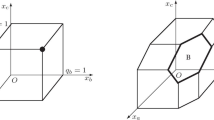For two players with identical preferences, cake-cutting procedures, such as Cut-and-Choose (Brams & Taylor, 1996) and the Surplus Procedure (Brams, Jones, & Klamler, 2006), guarantee that each player receives exactly half of the cake, according to their preferences. In essence, receiving exactly half is a worst-case scenario because when their preferences are not identical, the opportunity often exists for both players to receive more than half of the cake, measured by their preferences. This potential reward is balanced by risk, as these differences in preferences provide an incentive for players to misrepresent their preferences in an effort to gain a more valuable piece. In contrast, players may not be able to exploit information about an opponent's preferences when indivisible objects are allocated to two players, even when the players ' preferences are different. Our purpose is to determine the structure of, relationship between, and frequency of two players' preferences for which players receive their worst or best possible outcomes when dividing a finite set of indivisible goods, independent of strategic behavior.
Kohler and Chandrasekaharan (1971) pose and solve three optimization problems in which a finite set of players, with linear preference orders over the items, alternate taking turns selecting a number of items from a set of indivisible items. We adopt their framework, as Brams and Straffin (1979) do, to the case when two players alternate selecting a single item from a set of indivisible items. Although Kohler and Chandrasekaharan (1971) assume that players have values associated with each item and subsets are valued according to the sum of the values of its objects, like Brams and Straffin (1979), we assume that the players ' preferences for subsets of items are partially ordered, induced by the linear orders.
Access this chapter
Tax calculation will be finalised at checkout
Purchases are for personal use only
Preview
Unable to display preview. Download preview PDF.
Similar content being viewed by others
References
Aguiar, M., & Mahajan, S. (2006). Coxeter groups and hopf algebras. Providence: American Mathematical Society.
Björner, A., & Brenti, F. (2005). Combinatorics of coxeter groups. New York: Springer.
Bóna, M. (2004). Combinatorics of permutations. Boca Raton: Chapman & Hall / CRC.
Brams, S. J., Edelman, P. H., & Fishburn, P. C. (2003). Fair division of indivisible items. Theory and Decision, 55, 147–180.
Brams, S. J., & Fishburn, P. C. (2000). Fair division of indivisible items between two people with identical preferences: Envy-freeness, Pareto-optimality, and equity. Social Choice and Welfare, 17, 247–267.
Brams, S. J., Jones, M. A., & Klamler, C. (2006). Better ways to cut a cake. Notices of the American Mathematical Society, 53, 1314–1321.
Brams, S. J., & Straffin, P. D. (1979). Prisoners' dilemma and professional sports drafts. The American Mathematical Monthly, 86, 80–88.
Brams, S. J., & Taylor, A. D. (1996). Fair division: From cake-cutting to dispute resolution. Cambridge, UK: Cambridge University Press.
Edelman, P., & Fishburn, P. (2001) Fair division of indivisible items among people with similar preferences. Mathematical Social Sciences, 41, 327–347.
Kohler, D. A., & Chandrasekaharan, R. (1971). A class of sequential games. Operations Research, 19, 270–277.
Stanley, R. P. (1999). Enumerative combinatorics (Vol. 2). New York: Cambridge University Press.
Author information
Authors and Affiliations
Corresponding author
Editor information
Editors and Affiliations
Rights and permissions
Copyright information
© 2009 Springer-Verlag Berlin Heidelberg
About this chapter
Cite this chapter
Hopkins, B., Jones, M.A. (2009). Bruhat Orders and the Sequential Selection of Indivisible Items. In: Brams, S.J., Gehrlein, W.V., Roberts, F.S. (eds) The Mathematics of Preference, Choice and Order. Studies in Choice and Welfare. Springer, Berlin, Heidelberg. https://doi.org/10.1007/978-3-540-79128-7_15
Download citation
DOI: https://doi.org/10.1007/978-3-540-79128-7_15
Publisher Name: Springer, Berlin, Heidelberg
Print ISBN: 978-3-540-79127-0
Online ISBN: 978-3-540-79128-7
eBook Packages: Mathematics and StatisticsMathematics and Statistics (R0)




